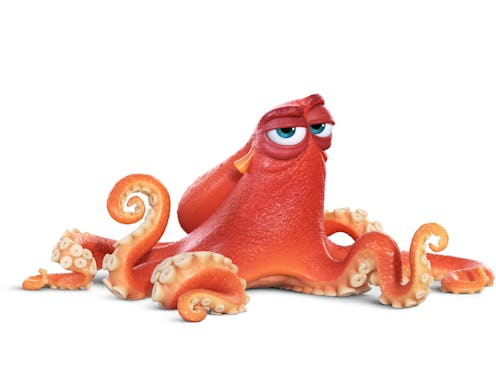
Pixar features take years for the computer animation studio to make, but their fans would agree that it's worth the wait for a technologically astounding final product. The company's latest release is Finding Dory, which hits theaters Friday, June 17. This new underwater adventure is a sequel to Pixar's Oscar-winning 2003 film Finding Nemo. And as if the visuals in that film weren't impressive enough, 13 years of advancements have occurred since audiences fell in love with Marlin, Nemo, and Dory's Great Barrier Reef home. One of the characters making his debut in the Finding Nemo sequel is Hank the octopus. (Well, he's missing one tentacle, so he's more like a septopus.) The slimy, slippery cephalopod is another detailed Pixar creation. How did Hank from Finding Dory get made?
Well, on April Fools Day of this year, Dory director Andrew Stanton and voice actor Ed O'Neill joked that Hank has actually been around as long as Pixar has. Hank is the type of octopus that can camouflage himself. So who can prove that he isn't in the background of every Pixar feature film ever made? Check out this video where Stanton calls Hank "the biggest secret" in the studio's illustrious history.
Jokes aside, Finding Dory character supervisor Jeremie Talbot told CNet that Pixar didn't have the technology to animate Hank back in 2003 — at least well enough to suit their high standards. Talbot's department generates the base puppet that the animators than insert into all kinds of dangerous and funny situations. One engineer spent half a year on Hank's original form. Making Hank look realistic required the definition of "a new type of curve" and embracing the "complexity of movement" of the actual animal, according to Talbot.
The painstaking work wasn't over once Hank's puppet was in good shape. The next phase of production was even more time-consuming. In his interview with CNet, Talbot estimated that Pixar animators spent two full years getting one Hank scene with lots of movement and several color changes exactly right. "Our shading artist, he actually applied an animated textural effect all over Hank's skin," Talbot explained. This step enabled the animators to "blend" Hank into different environments. Watch the video below to see more examples of the artistry behind Hank and his "drippy, squishy motion."

Modern Family star Ed O'Neill didn't have to worry about any of those effects as the voice of Hank. But in an interview with Collider, he does admit that the recording process was more difficult than he had anticipated. "You know, they schedule the sessions for four hours. And you're there alone. And in the case of Hank...there's a lot of frenetic, anxious [moments]," O'Neill remembered. "It was like running a marathon." Co-star Ellen DeGeneres (Dory) agreed: "It takes a lot out of you."
Clearly, lots of hours were logged putting this character together. So when you see Finding Dory this weekend, spare a thought for the animators, engineers, and artists that brought Hank and his seven tentacles to such glorious, organic life.
Image: Walt Disney Studios